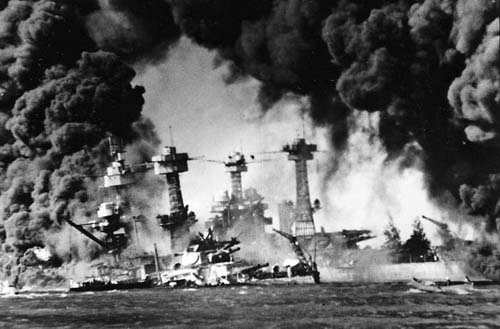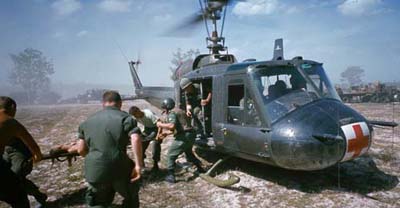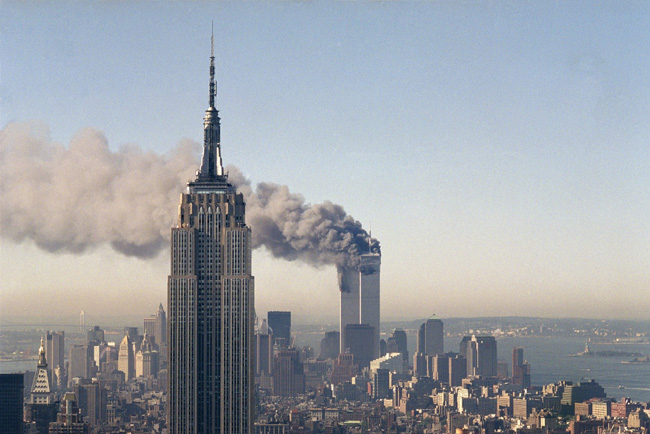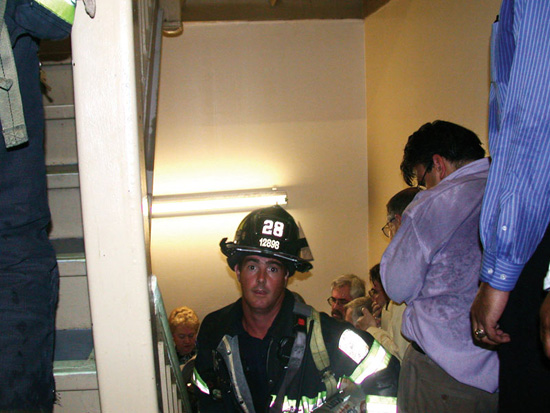Two Stories, Same Theme: 9/11 Redux
Keith Nightingale
I was standing in a parking lot and heard the unmistakable sound that is forever imbedded in our minds. Six UH1H’s flew across the sky in what we used to call a staggered trail formation. They were the blue and yellow helicopters of the county fire department and had just come from some commemoration ceremony. I had never seen so many together since retirement. The sight and sound instantly brought me back to my own memories of both helicopters and 9/11.

Every generation has a cataclysmic event that forever flashes for the participants - the visualization of the moment. Years pass and yet the greatest degree of detail is recalled from the major event itself to its most minor nuances. For my parents it was Pearl Harbor and the death of FDR. Each could recall with the greatest clarity their exact location and circumstances in minute precise detail. The precise location, who they were talking to, what was said and what they were wearing or eating. Such is the effect of a searing emotional moment in time.
During Tet of 1968, I was the senior advisor to the 52d Ranger Battalion. On one of our many tasks during that very eventful period, we were in the process of clearing the Province Chief’s compound at Baria, south of Saigon and north of Vung Tau. It was night and we were on an adjacent building rooftop. Green and red tracers were flying back and forth and the sky was lit with the many fires, explosions and impacts of two sides determined to succeed in their opposing missions.
In an instant, one of the battalion commander’s RTO’s was grievously wounded and fell in a heap next to me. Using normal procedures, I called through the advisor chain for a medevac. In time, we heard the call from the ARVN medevac, actually a pair, flying in tandem for the pickup. I vectored them toward me and saw them approach-one low in bound the other somewhat higher. The inbound pilot saw the crisscrossing green tracers and abruptly pulled up telling the battalion commander on the Vietnamese channel that it was too hot to land.

I informed the advisory HQ of this and requested an alternative medevac. Within fifteen minutes, a US medevac called in on my radio and announced his inbound. I signaled with a strobe which he acknowledged and swung into short final. At that moment, the VC unleashed a hail of automatic weapons fire toward our position and there were multiple streams of green coursing across our position. I saw the pilot abruptly do a quick power 90 degree turn and gain altitude. He, like his Vietnamese counterpart, said it was too hot to land.
I looked at the wounded RTO, now being administered to by a medic who glanced up from his near hopeless task with imploring eyes. I again called on the advisory net, informed them of the action and basically pleaded for anything that flew. Suddenly, a distinct voice came on the net with the usual throbbing tones of a pilot on a helicopter. I will call him Chocolate Six because I do not recall his real callsign.
“This is Chocolate Six. Mark your position. I will pick him up. Over.” I indicated a strobe which he rogered. I asked who he was and where he was. He responded that he was flying log missions for the 9th ID and the Aussies nearby at Nui Dat and had heard the several transmissions. I informed him that the wounded was a Vietnamese. He just said “I have your spot. Inbound. Standby.” The green tracers continued their wavering multiple paths as he hove into view silhouetted by the various illuminations of an intense combat zone. We guided him in and he hovered on the rooftop skids just touching the tiles. The medic and another soldier essentially threw the wounded soldier in the now open door held open by a wide-eyed crew member with bullets lacing the scene. The pilot immediately pulled pitch and lifted almost straight up, did a 180 degree turn and receded into the darkness.
I thanked him and said asked where he was taking his charge. He responded that his crew chief said the man was nearly dead and he would go directly to 93d Evac at Long Binh. I said, “He is Vietnamese. They may not take him, Over.” His response was, “He is going to 93d Evac. Out.” We went back to business.
Three weeks later, the soldier returned to us, now north of Bien Hoa, to relate that he had been in the 93d for more than a week in intensive care and then transferred to the Vietnamese hospital in Saigon. The Vietnamese liaison at the hospital told him that the 93d had saved his life when he landed and that he was one of more than a hundred they processed that night and his nationality was lost in the chaos. The pilot and his unit remained unknown.

Then 9/11. On the morning of 9/11, I, as always, came into the kitchen, made the coffee and turned on CNN-probably about 0630 Pacific time. The screen showed the twin towers, one smoking and on fire and the other next to it. The reporters were unclear as to what was happening other than a plane had crashed into it. Then out from the right screen, a second plane was seen to flow to the left and then back to crash into the second building. At that point, the issue of “terrorists” was first raised. This was not an accident. Quickly, there was news regarding other lost flights over Pennsylvania and Washington. Los Angeles was identified as a possible target.
The White House issued controlling statements and fighters were scrambled. In time, all Commercial flights were ordered to ground themselves. The Air Force would control the skies. Soon, the Pentagon was struck and a United flight crashed into a field in Pennsylvania. By now-probably Noon Pacific-the organization of the attacks began to emerge.
The news reporters said that several planes had hit the towers and terrorism was suspected. We sat and watched this unfold for the next hour plus. I had no thought of going to work and sat transfixed on the screen. First the fire and then the collapse of the buildings. Somehow I sensed from the moment of the second crash that the buildings would collapse and responded matter of factly when they did so.
My focus evolved from distant interest to direct engagement. I knew that my firm frequently had people in the buildings and had personally been in them not many weeks prior. Customs, DEA, FBI and others-all our customers, routinely had our employees there. I needed to start accounting for people.
The CEO, and others began a series of telcons to get a grasp on our situation. The telephone and cell structure was overwhelmed and Email was problematical. I learned that a key customer, Cantor-Fitzgerald Bonds, was all but wiped out. However, the CEO, due to a requirement to take a family member to a doctor, had stayed in New Jersey rather than go to his office in the Towers. He contacted us and asked that we try and reconstitute his trading capability asap. I thought this at first a venal request under the circumstances. Later, after fielding calls and participating in telcons with Treasury, the NSC, World Bank and others recognized that re-starting the trading was a core component of how America “does business” and was essential to our response. All that day, I stayed home and used the cell fone and email to assist in our recovery. Finally, I was able to state that we had no people in the Towers. We then focused on the future.
That night, the evening news, showed a comparative FAA radar picture of the United States airspace at 6PM 10 Sept. The country was filled with bright dots-each an airplane-with major concentrations clustered around our great cities. The same radar picture at 6PM 11 Sept showed an almost dark nation. The very few pin points being Air Force fighter and AWACS patrols. Our Nation was at war.
My company, as a scientific technical corporation, donated considerable equipment and systems to the Ground Zero recovery effort pro bono. Key amongst these donations were tiny robotic devices designed to go in the smallest areas with cameras and sensors. These were provided to the rescue effort to search the huge areas of collapsed structures for trapped people, bodies and damage assessment. They crawled through cracks in the rubble where neither humans nor dogs could go and went underwater in the flooded subway tunnels to pinpoint leaks and casualties. They brought an entirely new dimension to the recovery process.

Because of our donations to the effort, we were invited to visit Ground Zero in early October under the hosting of the City of New York Police and Fire Departments. The following narrative describes that visit as best I recall.
It was mid afternoon in early October. Five of us drove from New Jersey to the Fulton Fish Market on the East River. During the drive, we started out with the usual banter of businessmen. As the drive progressed, we became progressively quieter to the point where when we crossed the Verrazano Bridge, we were pretty much silent and remained so for the remainder of the trip-each of us lost in our own thoughts and the visualization of what had occurred on the left horizon as we saw the shadows and dimensions of the city unfold.
Around 4 O’clock, at the pier at Fulton, we were met by a Mayor’s representative and several police and fire officers. We went through subdued handshakes and conversation and boarded a police launch. The launch backed out to the East River and turned south skirting the piers of Manhattan and the decaying waterside of Brooklyn on our left. Each of us had perfunctory conversations with our hosts which uniformly segued into comments regarding where each of us were the moment/day the event occurred. Each of the hosts related of close friends and associates lost and how they were managing the family issues. Two of our five were retired military and we felt an immediate empathy for their experience. Oddly, one of the firemen was almost apologetic to me as he said-“You understand this. You must have seen much worse.” I said “I don’t believe I have seen anything like this.” By the time we were crossing what was 25th St, conversation ceased and we fixed on the horizon of the inner city to the west now resting in the twilight of dusk.
The launch turned west at the tip of Manhattan and moved toward Battery Park. For the first time, one could begin to perceive the effect of the event. Though the lights were on in many buildings, there were also visible voids. The light was sufficient to discern the coating of grey white which seemed to permeate and coat everything. Windows were visibly broken. There was not a single vehicle moving on the roads and almost no people. This got our attention. It was as if the greatest part of the most active city in America had ceased to operate. This was real. It wasn’t a science fiction disaster movie. On the launch, there was the same silence and sense of awe that visits one when entering a great cathedral or the memorial at the USS Arizona-a distinct impression that something important happened here that needs to be acknowledged.
The launch tied into Battery Park and we silently followed our hosts as they led us through the park, along the deserted avenue and toward Ground Zero. It reminded me of Tet in Saigon when I moved with my unit through dense deserted urban sprawl in total silence devoid of the usual human backdrop. The absence of people was startling-especially when we walked alone on the sidewalks surrounded by the unoccupied mega structures that are the signature of New York. Our feet crunched the powdered concrete as if it were a light snow. Tiny puffs of grey would burst up from each step. Quickly, our shoes and pants became coated with the pulverized dust.
The fall rains had not yet arrived. Every cranny and corner was coated with a fine powdered grey-white dust from the event. Glass dust like ice crystals sparkled in the light. Every ledge had a quantity of the powdered corpse residue of the twin towers. The air did not have a fresh fall smell. Rather it was an ambiguous odor of dirt and construction associated with some huge building project. Everywhere, it was silent and devoid of the expected noises of a city. One could sense a vibration and indiscernible sounds but they were too imprecise. We walked on in the twilight with a modest sound of crunching, smoking feet, each in our own thoughts. Over this short distance, our hosts had amalgamated together to our front. They were not hosting, they were apart from us. We were now two parties-the leaders and the led. We turned a corner.
A scene that will always live with me. We had arrived at the corner of Ground Zero. Looking west and north, the scene was apocalyptic. I turned the corner looking down at the ground and had to raise my head to an almost uncomfortable angle to view the immense sensory depriving scene. In front of us was an immense pile of indiscernible rubble. The concrete window facades, at many angles and forms were fixating as light from the city outlined their wild juxtapositions. Light beams passed through the window frames and danced upon the shards and emitting steam. Only gradually could one discern the movement of people and things on this huge reeking pile. Smoke seeped from many locations losing itself in the darkening sky.
This immense mass overwhelmed the senses. It was a JMW Turner painting giving a huge emotional impression but indiscernible detail. I stood still and tried to focus my mind. What am I looking at?
We were dumbstruck at the street corner and just stared at the scope of the scene. Imagine a detached observer at Omaha Beach or Gettysburg. Gradually, as we hunted for some anchor to the senses, the bits and pieces became more apparent. This is rebar. That’s a concrete flooring piece. A window frame. A pipe. A chair. A purse. A shoe. Parts of a tie. Parts of a telephone. The debris field of the Titanic on a far larger scale.
The whole was subdivided into many individual piles of great magnitude. Each had its complement of extraction, lifting and dozing machinery and assemblage of people. To my eye, each had its tiny lines of workers and lights focusing on a single point within the whole like so many shiny maggots working their away across a steaming, decayed corpse. To one side-northeast, an unbroken line of vehicles pointed toward the pile and another-composed of ambulances and open rubble haulers-away. For such a huge gathering of people and equipment, it was remarkably quiet.
How immensely inconsequential we seemed against the whole. The people seemed so tiny compared to the mass they worked. One had to remind oneself that these were people we were looking at as they were so easily lost within the twisting and obscuration of the debris, smoke, steam and wavering light.
As we moved forward and adjusted to the scene, we each focused on a piece of the whole-still silently led by our hosts who would occasionally relate a location or issue of a lost friend or element. Often, they would cease talking and be lost in thought and then only gradually return to association with us. We hardly noticed and took no offense
After the instant impression and confusion had passed, it evolved that each pile within the mass had a rhythm and order. That provided a comfort. Everyone had some sort of light activated marker-an armband, a fire coat striping or a glow tape hat. These would randomly flash and recede as various sources hit them. The effect was of continuously waving ribbons of light throughout the mass. Larger lights stabbed through the broken facades constantly throwing alternating surreal shadows and bright focal points on the piles.
The workers arranged themselves in a line snaking through the rubble between the point of excavation and the ambulances that awaited the results like fireflies against the night sky. At the point of excavation, a group of people-and usually one or more dogs-were on their knees looking into the abyss. A yellow claw grasp situated itself on the pile with the claw directly over the point of interest. The claw operator would respond to silent signals from the excavation leader. Twice in my presence, the leader called for a halt and the machines coughed into silence and the dogs descended into the dark. On each occasion, after some lifting and moving material, a body or parts were extracted. At each moment, the vehicles all stopped, the people on the pile stood erect and several individuals would move forward, go into the hole and emerge later with a body bag.
At that point, some form of silent signal was passed and this immense body of people and machinery within this huge mass would cease moving while the cortege passed down the glowing snaking line of workers to pass their burden to the waiting ambulance. Most people affected some form of salute as the group passed and many crossed themselves as they returned to their tasks though no order or comment was discerned. The effort had a sanctity that only such an event can impart. The immensity of the scene made the human presence appear minor and insignificant.
We watched this for several hours. I never left my pile and only occasionally looked at the rest of the scene. Our hosts were equally transfixed and stood mute with us. After several hours, now about 10 pm, they indicated we should depart. We walked silently back to the launch and were lost in our own thoughts as the boat plowed its way between the now illuminated skylines and docked. We rode in utter silence back to our hotel lost in our own thoughts. This was a day of days.
Looking at those helicopters fly by, I was flooded with old memories. But more than anything, I was mindful that one of the greatest aspects of our Nation is that we seem to have an inexhaustible reservoir of people who are willing to climb up the stairs when everyone else is running down and dropping the collective when others are pulling it.
